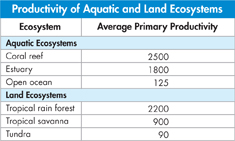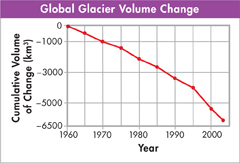Think Critically
Form a Hypothesis The deep ocean lies within the aphotic zone and is very cold. Suggest some of the unique characteristics that enable animals to live in the deep ocean.
Form an Opinion A developer has proposed filling in a salt marsh to create a coastal resort. What positive and negative effects do you think this proposal would have on wildlife and local residents? Would you support the proposal?
Connecting Concepts
Use Science Graphics
The following table presents primary productivity (measured in grams of organic matter produced per year per square meter) for several ecosystems. Use the table below to answer questions 33–36.
Interpret Tables According to the table, which ecosystem is most productive? Use what you know to explain that fact.
Infer The open ocean is among the least productive ecosystems, yet it contributes greatly to the overall productivity of the biosphere. How do you explain this paradox?
Apply Concepts For each set of ecosystems, aquatic and land, explain how abiotic factors may account for the differences in primary productivity seen. Give two examples.
Infer Review the description of the Northwest coniferous forest on page 114. Do you think its average primary productivity is greater or less than that of the tropical savanna? Explain your answer.
Write About Science
Explanation Choose one of the ten major biomes, and write an overview of its characteristics. Explain how abiotic factors and common plants and wildlife are interrelated. Support your explanation with specific examples.
Assess the
 How do abiotic factors influence what kinds of organisms are involved in the primary succession in an area following a volcanic eruption?
How do abiotic factors influence what kinds of organisms are involved in the primary succession in an area following a volcanic eruption?
Analyzing Data
The graph here summarizes the changes in the total volume of ice in all the world's glaciers since 1960. Note that the volume changes on the y-axis are negative, meaning an overall loss of volume.
Interpret Graphs The greatest volume of glacial ice was lost
between 1960 and 1970.
between 1980 and 1990.
between 1995 and 2000.
before 1960.
-
Relate Cause and Effect The most reasonable explanation for the loss of glacier mass since 1960 is
an increase in the total productivity of the world's oceans.
a gradual rise in Earth's average temperature.
an increase in the total amount of ice at Earth's poles.
an increase in the sun's output of radiant energy.
Table of Contents
- Formulas and Equations
- Applying Formulas and Equations
- Mean, Median, and Mode
- Estimation
- Using Measurements in Calculations
- Effects of Measurement Errors
- Accuracy
- Precision
- Comparing Accuracy and Precision
- Significant Figures
- Calculating With Significant Figures
- Scientific Notation
- Calculating With Scientific Notation
- Dimensional Analysis
- Applying Dimensional Analysis






